
“Kendrick Lamar’s half time show wasn’t boring or trash — it just went over your head” – Anonymous
Kendrick Lamar didn’t just perform at the Super Bowl—he delivered a masterclass in cultural storytelling. His set wasn’t just about the music. It was a statement. A reflection of Black history, identity, and struggle—wrapped in rhythm and movement. Every lyric, every visual, and every move was intentional. Let’s break down six hidden messages you might’ve missed in his performance.
1. UNCLE SAM / UNCLE TOM
When Uncle Sam…uel L. Jackson appeared in a red, white, and blue suit, it wasn’t just for show. It was a remix of Uncle Sam, America’s symbol of patriotism—but flipped on its head. And when Jackson called Kendrick “too loud, too reckless, too ghetto,” it was a deeper callout. This moment echoed the way Black artists and activists are often told to shrink themselves to fit into society’s expectations. It was also a subtle nod to the Uncle Tom stereotype, a historical reference to Black individuals who are expected to conform to white societal norms.
2. THE REVOLUTION WILL BE TELEVISED—BUT ON WHOSE TERMS?
“The revolution is about to be televised; you picked the right time but the wrong guy.” This line wasn’t just a lyric—it was a direct reference to Gil Scott-Heron’s poem The Revolution Will Not Be Televised. Scott-Heron’s original message was that real change doesn’t come through media-friendly spectacles; it happens in the streets, in communities, and through grassroots movements. Kendrick took that message and flipped it, suggesting that while the revolution is being watched, the people broadcasting it may not be the ones leading it.

3. MASS INCARCERATION IN AMERICA
If you didn’t notice, Kendrick’s entire set was designed to resemble a prison. The uniformity of the dancers, their synchronized movements—it all symbolized how mass incarceration disproportionately affects Black communities. Kendrick has spoken about this issue before in songs like Institutionalized and DNA. By putting it front and center in his performance, he forced millions of viewers to confront an issue that is often ignored in mainstream conversations.
4. THE AMERICAN FLAG: BUILT ON BLACK LABOR
At one point, the dancers came together to form an American flag. But then, they bent over, backs in the air—a haunting visual representation of how Black labor built this country. The imagery was striking. Shortly after, the flag split into two groups, a stark reminder of the racial and social divisions that still exist in America today. It was a bold statement, one that challenged the traditional narratives of unity that Super Bowl performances often try to sell.
5. 40 ACRES AND A MULE: A PROMISE NEVER KEPT
Before launching into Not Like Us, Kendrick dropped a powerful line: “40 acres and a mule, this is bigger than the music.” This was a direct reference to the unfulfilled promise of reparations made to freed Black Americans after the Civil War. The phrase has become a symbol of economic injustice and the racial wealth gap that persists to this day. By invoking it on one of the biggest stages in the world, Kendrick made it clear that this conversation isn’t going away anytime soon.
6. SERENA WILLIAMS: OWNING THE CRIP WALK MOMENT
The Drake diss in Not Like Us was already making waves, but Kendrick took it a step further by bringing out Serena Williams. Dressed in blue, she performed the Crip Walk—an iconic move she was once criticized for after winning Olympic gold. This time, though, she owned the moment unapologetically. It was a statement about reclaiming Black culture on a global stage, turning a moment of past scrutiny into one of celebration.
More Than a Performance—A Cultural Statement
Kendrick Lamar knew exactly what he was doing. His Super Bowl set wasn’t just a performance—it was a lesson, a conversation, and a declaration. He challenged the mainstream audience to look deeper, to question the narratives they’ve been fed, and to acknowledge the struggles that continue to shape Black identity in America.
Every beat, every move, every lyric had a purpose. And if you weren’t paying attention, you might’ve missed it.
Happy Black History Month.









